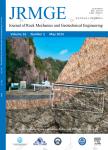A transition from a large open pit into a novel “macroblock variant” block caving geometry at Chuquicamata mine, Codelco Chile
A transition from a large open pit into a novel “macroblock variant” block caving geometry at Chuquicamata mine, Codelco Chile作者机构:Newcrest Mining Ltd.Melbourne3004Australia Codelco ChileSantiago8320000Chile
出 版 物:《Journal of Rock Mechanics and Geotechnical Engineering》 (岩石力学与岩土工程学报(英文版))
年 卷 期:2019年第11卷第3期
页 面:549-561页
核心收录:
学科分类:08[工学] 0801[工学-力学(可授工学、理学学位)]
主 题:Macroblock variant Block caving Cave propagation Early and late dilutions Intensive preconditioning Rib pillar West fault Ore buffer
摘 要:With a history of more than 100 years, Chuquicamata has become one of the largest open pits in the world. Its current depth of 1100 m, length of 4500 m and width of 3000 m, resulting in haulage distances of over 11,000 m from pit bottom to the processing plant or waste dumps, with waste/ore ratio greater than 4 and much lower grades, are effectively determining its profitable limit by the end of this decade. Currently, there are over 4300 Mt of geological resources containing 0.7% of copper and 340 ppm (1 ppm = 1 g/t) of molybdenum below the final pit shell. The corresponding orebody geometry is 3000 m northsouth, 300-800 m eastwest and the drilling campaign suggested the existence of more than 900 m of mineable ore from the final pit bottom. This is in spite of the fact that the Chuquicamata orebody is still open at depth. The business case to continue with the mining of the Chuquicamata orebody is to change from the current large open pit to a novel macroblock variant block caving geometry. This requires a production rate of 140,000 t/d (50 Mt per annum), with a continuous material handling system to achieve the 7-year ramp-up to full production. The resolution of a number of known technical, operational and logistical challenges outside current industry practises which Chuquicamata will face over its projected 40-year mine life is therefore essential. These challenges include simultaneous operations of open pit and underground macroblocks and from the initial lift to the second lift, rapid ramp-up and optimum sequencing of the planned macroblocks, early dilution from the west fault and late dilution from potential slope failures, and the potential for major operational hazards. An equally important issue to be addressed is cultural given that the mining history in the northern region of Chile, which includes Chuquicamata, is predominantly open pit. This paper presents a synopsis of the main challenges that the Chuquicamata underground project will face in order t



